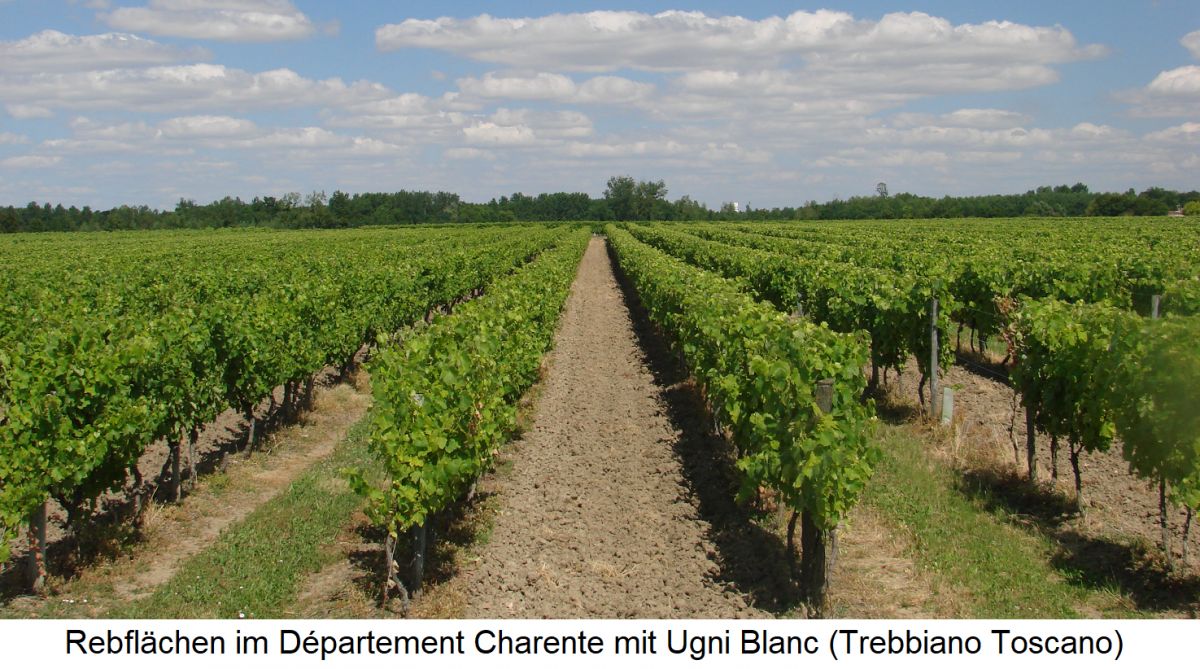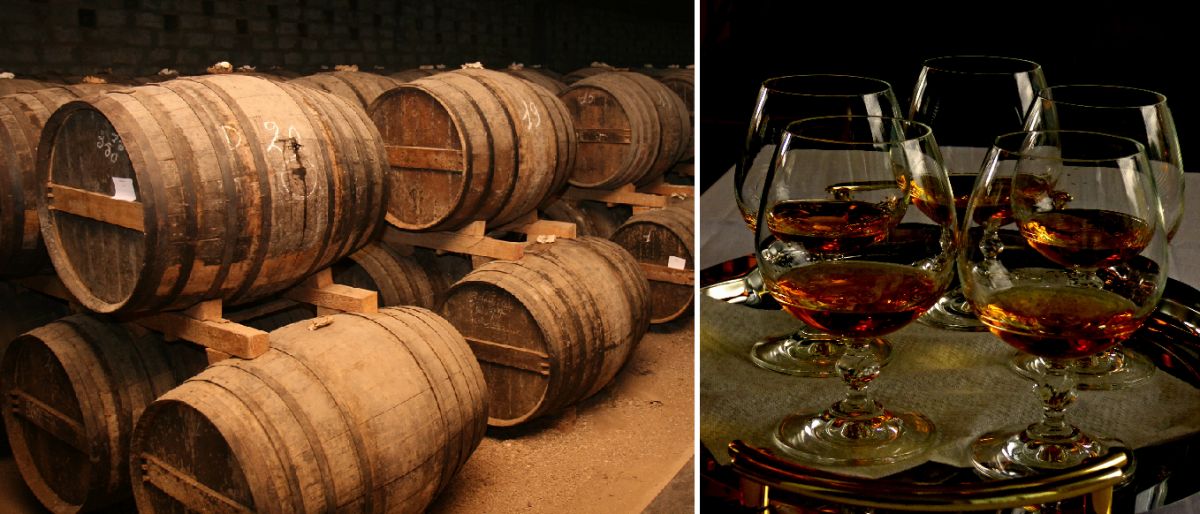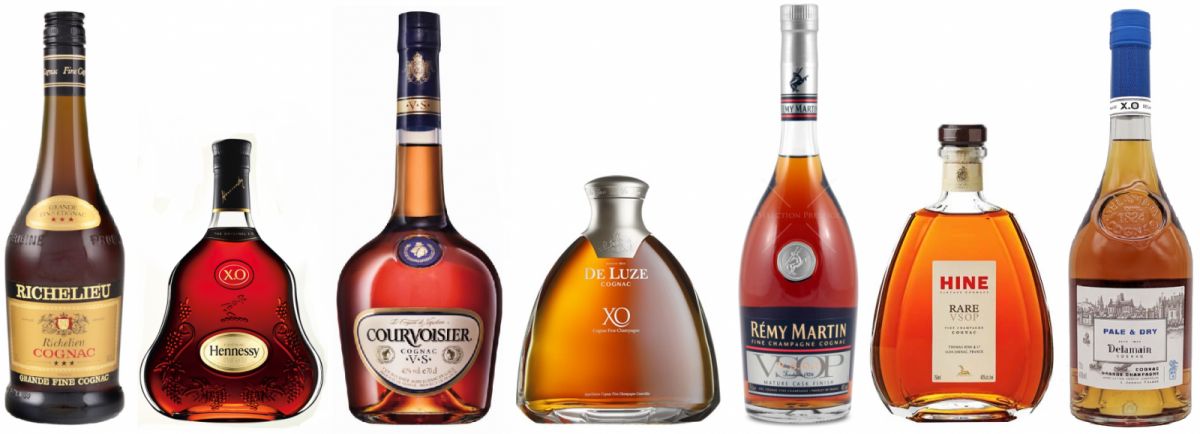Results
2,284 Results
Loading more Results ...
Loading more Results ...
Wine regions in Cognac 1 growing regions
Description to Cognac
Probably the most famous brandy in the world is named after the town of the same name in the Charente department just north of Bordeaux in south-west France near the Atlantic coast. When the Roman general Julius Caesar (100-44 BC) conquered Gaul, his legionnaires allegedly brought the Trebbiano grape from their homeland, which later became the main grape variety for Cognac. According to legend, the name of the Cognac region goes back to the Roman general Comnus. In the 12th century, spriting, the process of preserving wine by adding ethyl alcohol, was introduced. It also emerged that wine from the Cognac region was particularly suitable for distilling.

Around 1530, the Dutch introduced the art of distillation to this region, calling the wine distillates "Brandewijn", from which the English term brandy was later derived. At that time, it was common practice to produce distillates by distilling them once, as is still the case today with French Armagnac.
Invention of cognac
According to legend, the invention of cognac through a double distillation, which was unknown at the time, is attributed to the Chevalier de la Croix Maron, Seigneur de Segonzac (ancestor of the Castelbajac family of cognac producers) at the end of the 16th century. The deeply religious knight is said to have dreamt that the devil wanted to steal his soul by burning it out in a cauldron. However, thanks to his unshakeable faith, he survived the ordeal unscathed. A second attempt by the devil to distil the spirit was also unsuccessful, so the knight had the idea of extracting the spirit's soul with a second distillation.
The new drink quickly caught on due to its better flavour, and the Dutchman Augustin Godet was the first to receive state permission to export cognac. In 1634, the first cognac trading house "Maison Augier", which still exists today, was founded. A certain Jean Martell settled in Cognac in 1715 and produced cognac, followed by Richard Hennessy and others, who are still among the most renowned brands today.
Champagne Treaty
Articles 274 and 275 of the 1919 Treaty of Versailles were known as the "Champagne Treaty". These prohibited German products from bearing foreign designations of origin, which had been customary until then. This particularly affected champagne and cognac from German production, which from a French perspective were misleadingly named after French regions. Since then, these products have been labelled as sparkling wine and brandy.
Region of origin and grape varieties
Phylloxera arrived in this region around 1870 and destroyed many vineyards in the Charente. The current vineyard area of around 75,000 hectares is only a third of what it was back then. The basis for 90% of Cognac production is mainly Saint-Émilion/Ugni Blanc (Trebbiano Toscano), as well as Colombard and, to a lesser extent, Folle Blanche. In 2005, the new Folignan variety was also authorised with a maximum of 10% of the vineyard area per estate. As early as 1860, the French geologist Henri Coquand (1813-1881) and a professional brandy taster were commissioned to categorise the region in terms of quality.
However, it was not until 1909 that the boundaries and production regulations were defined. However, brandy continued to be labelled as Cognac outside France; Hugo Asbach (1868-1935) had marketed his product as Cognac brandy from 1896. In order to protect their brandy from German competition, the French enforced in the Treaty of Versailles that from 1920 only brandy from the Cognac region could be labelled as such. This is one of the few provisions of the Treaty of Versailles that is still valid today. Incidentally, Cognac was officially recognised as the first foreign geographical indication in China on 18 December 2009.
The Cognac region is located in south-west France, 100 kilometres north of Bordeaux. It includes the entire department of Charente-Maritime, a large part of the department of Charente, two enclaves in the departments of Dordogne and Deux-Sèvres as well as smaller islands off the Atlantic coast. The "Région délimitée" was divided into six zones grouped in concentric circles around the town of Cognac. The Grande Champagne area (also known as Grande Fine Champagne) is home to the best products, which are also entitled to bear this designation.
Around 15% of production comes from here. The soil is characterised by a high chalk content, which decreases significantly in the no less well classified areas. The others in the quality ranking are Petite Champagne (20%), Les Borderies (5%), Fins Bois (40%), Bons Bois (17%) and Bois Ordinaires (3%). Maximum yields (102 hl/ha), grape varieties, distillation type and storage methods were also defined by law. A product may only be called Cognac if the grapes come from this region, were distilled here and have also matured here. Incidentally, the production of pomace brandies is not permitted in the Cognac region.
Production process
Fermentation takes around 10 to 21 days. After two to three weeks of storage, the first distillation takes place. The fractionated method is used, and unlike Armagnac, the distillation is carried out twice in succession (Charentais pot still). The wine is unclarified, which means that the yeast that has not been removed is also distilled. After the first distillation, a distillate (Brouillis) with 25 to 30% vol. is produced, after the second distillation a product known as Bonne Chauffée (good heat) with a maximum alcohol content of 72% vol. The still water-clear cognac is stored in oak barrels, mainly from the Tronçais region, with a volume of 340 litres. During storage, the alcohol content gradually decreases and the cognac takes on its typical golden-brown colour.
After a few years, the distillate is transferred to larger barrels of 540 litres and continues to mature. Cognacs of different ages from different zones are usually blended. However, there are also vintage products whose production is specially controlled (see Vintage Cognac and Early Landed Cognac). The final product of around 40% is created immediately before bottling by dilution with faible (distilled water with a little alcohol). With a few exceptions (unlike Armagnac), Cognac is not labelled with a vintage year.

Up to 2% cane sugar and caramelised sugar may be added. The age is indicated by legally protected designations, whereby this refers to the barrel ageing period (a brandy no longer matures after bottling, this time does not count). Almost every renowned cognac producer uses a special room for this purpose, the so-called Paradis. The loss through evaporation is up to 5% per year, this is the "Part des Anges"(angel's share), which must be replaced by "Réserve des Anges" (RDA). The production and ageing period is strictly monitored by the industry association BNIC (Bureau National Interprofessionnel du Cognac).
Age classes & designations
The age of the cognac is determined by the youngest distillate it contains. Cognac may only be bottled and marketed if it has been stored in barrels for at least two years (Compte 02 = Account 02). Each distillate is initially labelled "Compte 00" (account 00). The first cut-off date is 1 April; such a cognac is at least one day to a maximum of three and a half months old (matured in cask). On 1 April of the following year, these distillates are aged for at least one year in cask and are labelled "Compte 01". This continues until "Compte 06" (six years), when the BNIC's control ends.
Depending on the Cognac house, however, the Cognacs mature for up to 20 years and longer. Cognacs in the higher categories from account 7 onwards are generally much older than the minimum requirements. A Cognac labelled Paradis, Grande Reserve or Family Reserve can be up to 100 years old. Per compte/account, a multitude of sometimes confusing fantasy designations can be found on the label. The exact age cannot be deduced from this:
- Compte 2: three stars (in the past up to 7 stars were used), Authentic, De Luxe, Elegance, Grand Choix (Grand Selection), Monopole, Selection, VS (Very Special or Very Superior)
- Compte 3: Crest (summit or top product), Cuvée Speciale, Fine, Grande Selection, Privilege, Qualité Speciale, Superieur, Très Bonne (very good)
- Compte 4: Premiere Croix, Rare, Reserve, Vieux, VO (Very Old), VSOP (Very Special Old Pale or Very Superior Old Product), VVS (Very Very Special or Very Very Superior)
- Compte 5: Cuvée Reserve, Grande Fine, Grande Reserve, Reserve de la Maison, Reserve Particuliere, VVSOP (Very Very Special Old Pale or Very Very Superior Old Pale)
- Compte 6: Age Inconnu (age unknown), Extra, Family Reserve, Grande Reserve, Hors d'Age (exceptional age), Imperial, Napoleon (see the background to the name there), Paradis, Très Rare (very rare), Très Vieux, XO (Extra Old), Vieille Reserve, VXO (Very Extra Old)
Producers
A cognac (brandy) is usually drunk from the typical cognac glass with a bulbous body. The largest and most important cognac houses, some of which also produce Armagnac and champagne, include the brands González Byass (sherry house), Camus, Courvoisier, Delamain, Desmaurin, Godet Frères, Hennessy, Thomas Hine, Marnier-Lapostolle (Marnier), Martell and Rémy Martin (Rémy Cointreau).
Not all grapes from the Cognac region are turned into brandy. Part of the harvest is processed into country wine in the Charente department. Pineau des Charentes, which is classified as an AOC, is a so-called high-alcohol vin de liqueur. Esprit de Cognac" is a high-quality, light-coloured cognac that is used as part of the "liqueur d'expédition" in the dosage of a champagne, as the sugar can be dissolved in it without affecting the taste.

Further information
For the production of alcoholic beverages, see Champagne (sparkling wines), Distillation (distillates), Spirits (types), Winemaking (wines and wine types) and Wine law (wine law issues).
Image Charente: By TobiToaster - photographed by himself, CC BY-SA 3.0, Link
Recent wines 1
More information in the magazine
- Plaimont - The vine rescuers from south-west France Advertisement
- Good Bordeaux doesn't have to be expensive! Crus Bourgeois
- Paradisiacal times! Tasting: European sparkling wines for the festive season
- Liv-ex classification: The fine wine market 2023 France is the measure of all things
- Domaine Combier Collection of the Year 2022 - Rhône
- The collections and discoveries of the year 2022/2023 tasting season
- Social responsibility in the name of wine In Focus: Vignerons Engagés
- AB, Vignerons Engagés, HVE, Terra Vitis: what are the differences? Organic certifications for French wine
- A lot of power for little money In Focus: Côtes du Rhône Villages Rouge
- Saving your account with pleasure In Focus: Crozes-Hermitage

